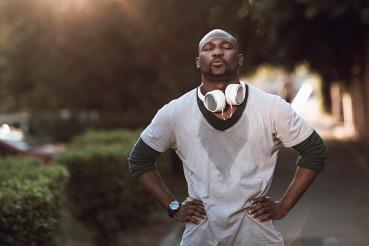Exercise is essential to good health. But if you don't use common sense while working out, you're putting yourself at risk for injury.
As a primary care and sports medicine specialist at Rush University Medical Center, as well as a team doctor for the Chicago Bulls and Chicago White Sox, Kathy Weber, MD, MS, sees firsthand the injuries that can result from overdoing it or not using proper form during physical activities.
Here, she offers advice for safer workouts — and explains why the latest exercise craze can potentially do more harm than good.
Common exercise-related injuries.
Exercise-related injuries are commonly overuse injuries, such as stress fractures, muscle strains, patellar tendinitis or rotator cuff tendinitis, and iliotibial band syndrome (a hip disorder from injury to the thick band that runs from your hip to the outside of your knee). Basically, any activity that involves repetitive movement — running, cycling, hitting a tennis ball, swinging a golf club, etc. — can cause damage to a specific area or areas of tissue over time.
Injuries can also occur when you're not properly conditioned for a certain type of exercise, or when you return to an activity too quickly and don't give your body time to adjust to increased levels of activity.
Always start out slowly in terms of both the duration and the intensity so your body has time to adapt. You should gradually increase first the amount of time and then the intensity level of your workouts. Depending on your level of conditioning when you get started, you may do only 15 to 20 minutes per workout the first week or two. But that's OK.
After you've built up your endurance and have a great baseline, then you can start to work out at a higher intensity. If you do a gradual build, you'll be a lot less likely to end up with overuse injuries.
Also, make sure that you're giving your body a sufficient recovery period between activities. Recovery time should always be individualized. Initially, a day or two in between exercise bouts should be adequate, but make sure to listen to your body.
Clues that you are not allowing enough recovery time may include continued muscle soreness and/or fatigue. If you try doing high intensity workouts seven days a week, the risk of breaking down and sustaining an injury is high. Your body needs time to recover and rebuild. That's true even for elite athletes. They train hard, but they also take time to rest.
Yoga safety.
It's interesting that yoga is generally perceived as this relaxing Zen kind of thing. But the thing about yoga is that it can involve getting into positions that your body hasn't adapted to, and that's when injuries may occur.
If you're starting out and have never done yoga before, use common sense as you would with any type of exercise program. If your body doesn't seem able to get into a pretzel position, that's probably not a good position for you. If you feel pain, that's a sign something’s wrong.
When you're in a class setting, you may push yourself too hard because everyone around you is doing these positions, so you think you should be able to do them, too. You may feel a bit of embarrassment or self-consciousness. What you need to remember is that some of these people who make it look so easy have been doing yoga for a long time.
Just take a moment and ask yourself, "Does this seem like a position that is comfortable for my body? Since I'm just starting this, should I really be trying to put my foot behind my head?" If you ease into it and use common sense, you'll be less likely to get hurt.
We all want to get in shape and lose weight yesterday, but as we get older, it takes more time for the body to adapt to changes. You have to think of exercise as a lifelong pursuit — it's a marathon, not a sprint.
No pain, no gain?
It's true that you might experience a little muscle soreness from exercise and feel achy the next day. But pain is always an indicator that something is not right. If you have pain that's not going away on its own, and if that pain is affecting your quality of life — including your ability to participate in physical activities — you should get it checked out.
When we say "no pain no gain," we're talking about Olympians and high level athletes who are really pushing hard to achieve and excel and be competitive. For everyday folk, "no pain no gain" shouldn't be the mantra. You should feel like you worked out hard, but you shouldn't feel like you have to sit down because you just killed yourself.
Most strains heal on their own within 4 to 6 weeks. But for instance, if you're at the gym and you tweak your shoulder, and it's still bothering you after a couple of weeks of rest and ice, make an appointment with an orthopedic specialist.
Don't try to tough it out, and definitely don't engage in activities that may make the injury worse. Of course, if you're exercising and you feel something pop and have immediate pain or swelling, or if you hit your head, you should see a doctor right away.
The reality of DVD-based workout programs.
People assume that if there's a hot new program like P90X that everyone — including celebrities — is trying, it must be the best program. But what's right for one person isn't necessarily right for another.
The reality is, I’ve seen a lot of P90X injuries in my practice. You're given a DVD featuring someone who is supposedly an expert in their field, and you're trying to mimic the exercises with no supervision. No one is telling you if you're doing everything correctly; you're just following a DVD.
But what you need to keep in mind is that there are some exercises people with certain conditions shouldn't do. For example, if you have knee problems, you may not want to do exercises that are high impact or require you to twist your knees.
If you want to try a DVD-based program, I suggest not trying to do the whole DVD the first time. P90X is a 90-day program, and that's a lot of exercise for the body to adapt to quickly, which is why it’s easy to injure yourself.
Start out doing 10 to 15 minutes at a lower intensity, and if an exercise doesn’t feel comfortable or you're not sure about the proper way to do it, skip that particular exercise. Gradually increase the amount of time you spend on the workout. Once you're able to do the whole DVD at a moderate level of intensity, then you can start to increase the intensity.
We all want to get in shape and lose weight yesterday, but as we get older, it takes more time for the body to adapt to changes. You have to think of exercise as a lifelong pursuit — it's a marathon, not a sprint.
Creating a safe and successful exercise program.
I would say the key is doing a variety of exercises — asking your muscles to do some different activities and working different muscles in your body, giving specific muscle groups breaks. Also, your program should include flexibility, strength and aerobic components. That's extremely important.
If you're stronger, you'll have better endurance and be less likely to sustain injuries. People like to do activities at which they excel. I have patients who are very flexible and don’t need to work on their flexibility, but they are drawn to activities that require greater flexibility, like yoga, because they're good at it. I also see people who are very good at aerobics, and that's all they want to do; they don't want to lift weights.
But they should be doing some weight training because fitness is really about balance: You need to have good flexibility, good strength and good aerobic conditioning to optimize your body's overall condition.




